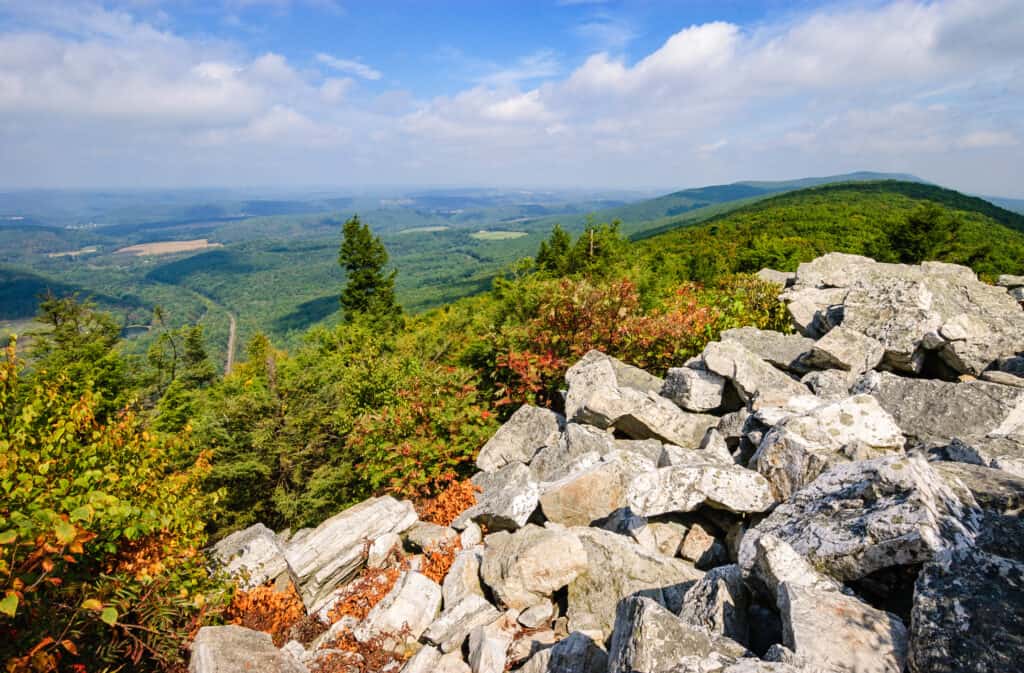Pennsylvania is not one of the most seismically active states. There have been 14 earthquakes at or above 1.0 magnitude in Pennsylvania. The largest one was 3.4 magnitude in Mifflintown in Juniata County. There was a 2.2 magnitude earthquake in Washington County in western Pennsylvania.
However, the most active town according to the earthquake index is Pequea, though it only has a rating of 3.79. Compared to other towns in the country, that is still very low.
How Many Earthquakes Does Pennsylvania Have?

While Pennsylvania isn’t particularly active seismically, the Appalachian Mountains are more prone to earthquakes than other parts of the state.
©Zack Frank/Shutterstock.com
Pennsylvania is not very seismically active. However, there are some areas that may be more prone to earthquakes, such as the Allegheny Plateau, the Appalachian Mountains, and the Delaware River Valley.
The average number of earthquakes in Pennsylvania is about six each year. Of course, some years have more and others have fewer.
Most earthquakes in Pennsylvania are very small and rarely cause damage. In fact, most residents sleep through the earthquakes or report not having felt them at all.
What Is the Earthquake Index?
The earthquake index is a measure of how likely an area is to experience an earthquake in the future. It’s based on the frequency of earthquakes in the area, as well as the geology and tectonics of the region. The index is listed in the range of 0 to 100, with 0 being practically no risk.
Pennsylvania as a whole has a rating of 0.70, compared to the national average of 1.81. The town of Pequea has an earthquake index of 3.79, though, which is much higher than the average in Pennsylvania.
With that said, that is still a very low risk compared to other cities and even whole areas of the world. However, this does not mean that earthquakes are impossible in Pennsylvania, as they can still occur due to natural or human-induced causes. Therefore, it is important to be prepared and informed about earthquake hazards and safety measures.
Pequea

The town of Pequea is small, with a population of just over 5,000 people.
©Naturelust/Shutterstock.com
Pequea has a small population of about 5,000 people.
This town has the highest earthquake index in the state at 3.79. That’s well above the state average of 0.7 and the national average of 1.81. This means that Pequea has a much higher probability of experiencing earthquakes in the future compared to other areas of the country.
However, that doesn’t mean that Pequea is at a higher risk of earthquake damage, as earthquakes in the area tend to be very weak. Plus, the earthquake index does not take several other factors into account that affect earthquake damage, like the intensity and duration of the earthquakes.
The only thing the earthquake index measures is the possibility of an earthquake.
With that said, Pequea has yet to experience a serious earthquake in its history. Most of the earthquakes that have occurred nearby were small and harmless. Therefore, Pequea is still considered a low-seismicity area, but it is advisable to be aware and prepared for potential earthquake hazards.
How Do Earthquakes Affect the Wildlife in Pequea?

Ospreys are just one of many bird species that live in the area around Pequea.
©Martha Marks/Shutterstock.com
There are many species of animals that live in and around Pequea, as it is surrounded by natural areas. For instance, bald eagles, ospreys, great blue herons, woodpeckers, and hummingbirds all call the area around this town home.
The effect of earthquakes on animals is not very well studied, sadly. Furthermore, all known cases of wildlife disruption caused by earthquakes involved very significant earthquakes, which likely won’t occur in Pequea.
The most obvious risk to wildlife is injury and death, particularly with very large earthquakes. Landslides, rockslides, soil liquefication, and similar earthquake effects can directly injure wildlife. Wildlife can also be buried under structures or hit by flying objects.
Earthquakes can also destroy habitat, or at least degrade it. Rivers, forests, and wetlands are at the highest risk, but just about any habitat can be affected by earthquakes. This reduces the availability of food and shelter for animals, causing some to die in the days after the earthquake.
In some cases, earthquakes may even destroy nesting sites, leading to severe population loss.
Earthquakes can also disrupt animals in a way that makes it hard for them to survive. For instance, migration paths may be blocked, or animals may flee into a habitat that cannot support them.
In some cases, earthquakes may cause behavioral changes in animals, at least in the short term. Some animals may become aggressive or stressed. Some may change their feeding and mating patterns, which can affect their long-term survival chances.
Where is Pequea Located on a Map?
Pequea is actually an unincorporated community that is located in Martic Township in Lancaster County, southcentral Pennsylvania. It is situated where Route 324 ends at the Susquehanna River, 12 miles south of Lancaster. There are many rural homes here, including many Amish communities.
Thank you for reading! Have some feedback for us? Contact the AZ Animals editorial team.







